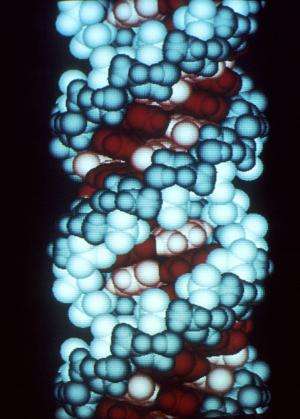May 13, 2016 report
Chemists offer more evidence of RNA as the origin of life

(Phys.org)—A team of chemists at Ludwig Maximilian University of Munich has shown how the purines adenine and guanine can be synthesized easily and in reasonable yields, offering more evidence that RNA could have served as the origin of life on Earth. In their paper published in the journal Science, the team describes the process they took in looking for evidence that RNA could have been the first self-replicating molecule that eventually led to all life on our planet and what they found.
For several years many scientists have supported the idea that life got its start on our planet due to a series of events that led to the creation of RNA molecules—it seems like a strong candidate because it is able to both store information and act as a catalyst. To bolster the theory, scientists have been trying to show under what conditions RNA might have come about based on the conditions that existed on early Earth. In the early going, researchers found it relatively easy to show how two of the four main building blocks in RNA, uracil and cytosine, could have come about, but showing how the other two, adenine and guanine, might have come about has been problematic. In this new effort the research team describes a scenario under with both might have come about given conditions at the time that life is believed to have got its start.
The team started by extending prior research that had shown that a molecule called formamidopyrimidine can react under certain conditions to form purines—they discovered that adding acid to an amine (which the team showed could have come about very easily from plentiful carbon, nitrogen and hydrogen) allowed for a reaction that led to the formation of a purine and that it would easily bond with formic acid, which recent research has shown is plentiful on comets—that means it could have met with existing purines if a comet crashed into the planet at the right place. Once that happened, the resultant reactions would have led to forging bonds with sugars which would have resulted in the creation of large amounts of purines, including adenine and guanine—thus all of the necessary ingredients would have been in place for the creation of RNA molecules, setting the stage for the development of living organisms.
More information: S. Becker et al. A high-yielding, strictly regioselective prebiotic purine nucleoside formation pathway, Science (2016). DOI: 10.1126/science.aad2808
Abstract
The origin of life is believed to have started with prebiotic molecules reacting along unidentified pathways to produce key molecules such as nucleosides. To date, a single prebiotic pathway to purine nucleosides had been proposed. It is considered to be inefficient due to missing regioselectivity and low yields. We report that the condensation of formamidopyrimidines (FaPys) with sugars provides the natural N-9 nucleosides with extreme regioselectivity and in good yields (60%). The FaPys are available from formic acid and aminopyrimidines, which are in turn available from prebiotic molecules that were also detected during the Rosetta comet mission. This nucleoside formation pathway can be fused to sugar-forming reactions to produce pentosides, providing a plausible scenario of how purine nucleosides may have formed under prebiotic conditions.
Journal information: Science
© 2016 Phys.org




















